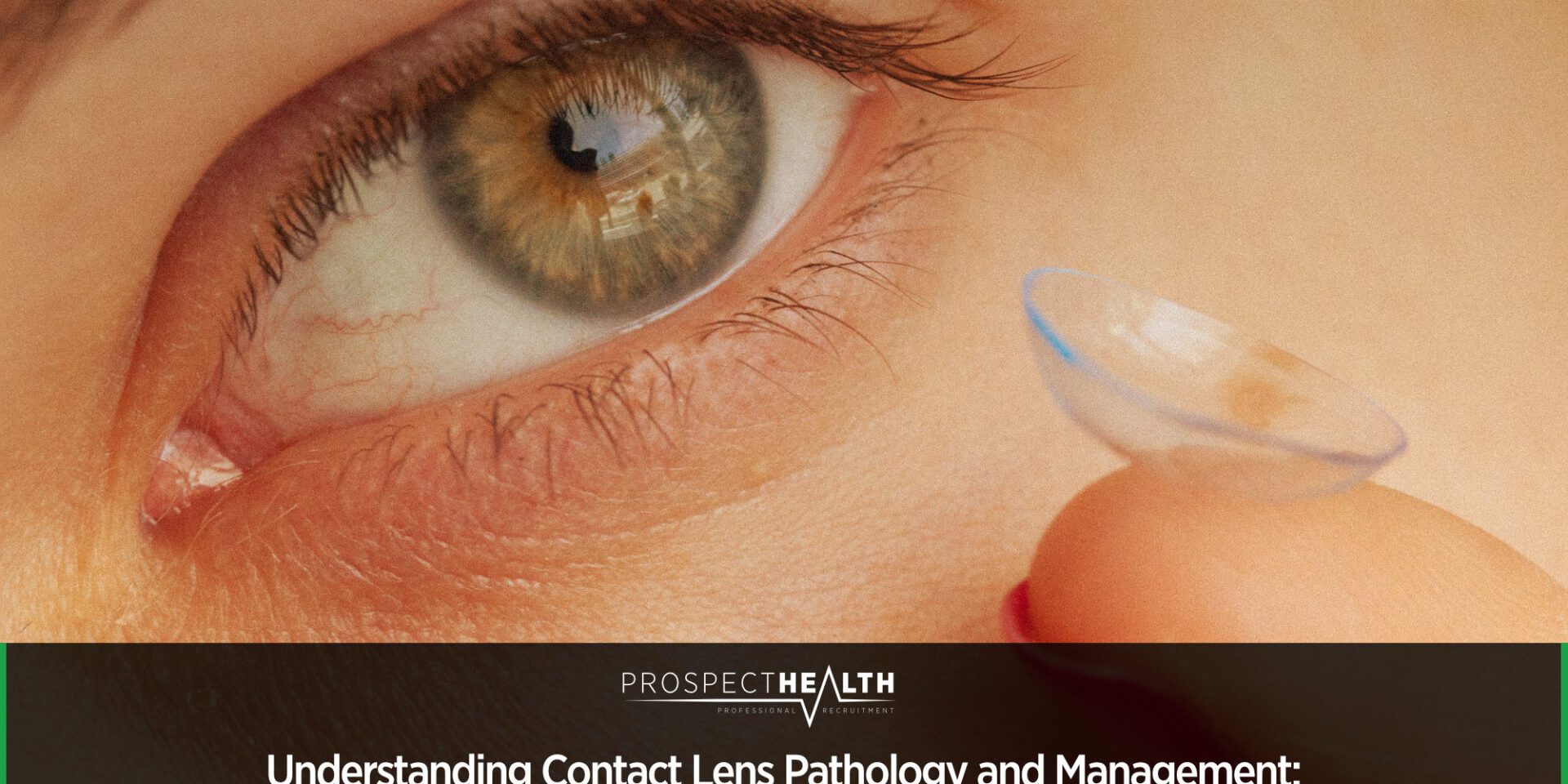
Understanding Contact Lens Pathology and Management:
A Deep Dive for Optometry Students
Part of our Webinar Series of Guides for Optical Students and Pre-Registration Optometrists
When it comes to contact lens wear, understanding the subtle differences between various pathologies is key to managing patient comfort and ocular health.
In her webinar, Aneesa Chowdhury explores common and uncommon contact lens-related pathologies, their causes, clinical signs, and management, all essential knowledge for any aspiring optometrist.
To access all our pre-recorded webinars via our online learning management system, please complete the form below

Access our pre-recorded Optometry Webinars
Below is a summary of the main learning points from the webinar:
1. Epithelial Microcysts
Epithelial microcysts appear as tiny scattered dots visible under retro illumination, often showing reversed illumination due to their higher refractive index. They consist of non-viable epithelial cells migrating from the basal layer to the surface.
While small numbers are normal and asymptomatic, large numbers can cause reduced visual acuity. These typically arise due to chronic hypoxia from extended wear of hydrogel lenses with low oxygen permeability (low Dk).
Key Points:
- Cause: Prolonged hypoxia → metabolic stress → reduced oxygen uptake → epithelial thinning
- Common in: Hydrogel extended wear lenses
- Resolution: Improves after switching to high Dk materials (e.g. silicone hydrogel)
- Management:
- Switch from hydrogel to silicone hydrogel or rigid lenses
- Ensure appropriate lens fit and oxygen permeability
- Reassess after 3 months — microcysts often reduce significantly
2. Mucin Balls
Mucin balls are small, round, translucent bodies located between the posterior lens surface and the cornea. They often resemble collapsed doughnuts and can be seen using retroillumination techniques.
They are common in silicone hydrogel extended wear, not due to hypoxia but due to the material’s increased modulus and stiffness, which induces shearing forces during blinking.
Key Points:
- Common signs: Small, stationary translucent rings behind the lens
- Symptoms: Usually asymptomatic unless numerous or in the visual axis
- Causes: Lens stiffness, prolonged wear, tear film characteristics
- Management:
- Switch from extended wear to daily wear
- Use a lens with lower modulus
- Prescribe ocular lubricants for a flushing effect
3. Corneal Staining
Corneal staining is one of the most frequently observed signs in contact lens wearers. It presents as punctate, diffuse, or coalescent hyperfluorescent areas, indicating epithelial disruption.
Common Causes:
- Mechanical trauma from lens movement
- Solution toxicity (especially with PHMB-containing solutions)
- Dryness and poor tear distribution
- Ill-fitting lenses
- Management:
- Adjust lens parameters (edge lift, thickness, diameter)
- Use more wettable materials or mini-sclerals/hybrids
- Reduce wearing time
- Review and change solution or care regime
4. Solution-Induced Corneal Staining (SICS)
SICS is typically seen beyond the limbus and peaks 1–2 hours after lens insertion, resolving after lens removal. It’s most commonly linked to PHMB-based multipurpose solutions.
Key Points:
- Symptoms: Mild burning or discomfort (often asymptomatic)
- Cause: Solution toxicity, not cell death (as fluorescein uptake requires viable cells)
- Management:
- Change to a different disinfecting solution
- Consider hydrogen peroxide systems for sensitive patients
5. SEALs — Superior Epithelial Arcuate Lesions
SEALs appear as arcuate staining in the superior cornea, caused by mechanical interaction between the lens and upper lid. They are commonly associated with stiffer, higher-modulus materials like silicone hydrogels.
Management:
- Cease lens wear temporarily
- Refitting with softer or thinner-edge materials
- Increase Dk if metabolic cause suspected
- Treat secondary infection if present
6. Contact Lens-Associated Infiltrative Keratitis (CLAIK)
CLAIK can be non-severe or severe, and though relatively uncommon, should always be taken seriously. It presents with infiltrates, often in extended wear users, but can also occur with daily lenses.
Management:
- Same-day referral for suspected keratitis
- Always treat contact lens peripheral ulcers (CLPU) as microbial keratitis until proven otherwise
- Pseudomonas is the most common pathogen (responsible for >50% of cases)
- Ensure patient brings their lenses for microbial swabbing
7. Giant Papillary Conjunctivitis (GPC)
GPC is an immunological response to lens deposits or mechanical irritation from stiff lens materials. It presents with papillae on the tarsal conjunctiva, often accompanied by itching, mucus discharge, and lens intolerance.
Management:
- Cease lens wear for 2–4 weeks
- Switch to more frequent replacement lenses
- Prescribe mast-cell stabilisers or antihistamines
- Regular follow-ups — papillae may take time to resolve
8. RGP Complications
Although RGP lenses are less common, they come with distinct complications:
Common Issues:
- Corneal abrasions: Due to handling or damaged lenses
- Dimple veiling: Air bubbles trapped under a steep lens, visible with fluorescein
- Three-and-nine o’clock staining: Due to inadequate tear distribution at the periphery
- Management:
- Adjust lens curvature or diameter
- Increase edge clearance
- Use lubricants and reduce wear time
- If untreated, can lead to peripheral thinning and scarring (Dellen)
Final Thoughts
Contact lens complications range from mild staining to sight-threatening keratitis. As an optometry student, understanding pathophysiology, recognition, and management of these conditions is crucial to ensure safe lens wear and excellent patient outcomes.
Remember: when in doubt, refer. Early recognition and appropriate management protect not only your patient’s vision but also your confidence as a future clinician.
Are you preparing for your OSCEs and looking for career guidance too?
Prospect Health works with over 100 employers eager to hire newly qualified optometrists.
Alongside revision support, we can help you secure the right role for you when you qualify.
You can call us at 01423 813 452 or email us at [email protected]
Or view the rest of our Optometry jobs here!

Next up: Getting the Full Picture: A Guide to Taking an Effective Patient History for Optometrists
Understanding a patient’s story is one of the most crucial skills in optometry. Before you ever reach for a diagnostic tool, your patient’s history can tell you more than you might imagine. Each symptom has a backstory, and your goal as a clinician is to master that story.
In our webinar, History Matters: Getting the Full Picture, Indy walked you through how to take an effective patient history using a structured approach, what to observe before the patient even speaks, and how to translate symptoms into meaningful diagnostic clues.

Talk to a specialist:
VICTORIA ASHTON
Specialist Recruitment Consultant
I am an experienced recruitment professional with a diverse background spanning GP recruitment, the Commercial sector, Practice Management, and most recently, Optometry.
After completing my degree as a mature student, I embarked on my recruitment career and have since found the industry both challenging and rewarding…


